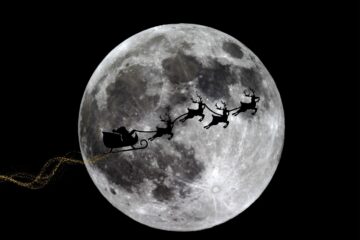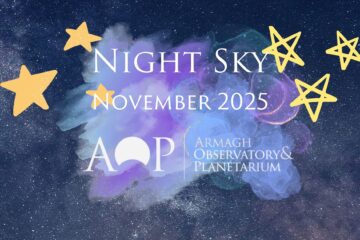It’s BBC Stargazing Live month, so even more of us will be looking skyward this January. What is there to see in the heavens these winter evenings?
We are treated to several naked eye planets are this month. These “wandering stars”, as they were called by the ancients are easily found.
Just after sunset the first ‘bright star’ that appears in the south is none other than Jupiter, the greatest gas giant which is residing in Aries at the moment. Shining at magnitude -2.4 you can’t miss it.
The Evening Star, Venus, is shining brightly at magnitude -3.9 and is visible low in the west for a couple of hours after sunset but you need a clear horizon to spot it after sunset.
Mars, rising in the east, appears on the scene around midnight and is visible for the rest of the night, the Red Planet shines at magnitude -0.4 by the end of the month, so is prominent in the early morning sky and can be found near the tail of Leo.
Saturn is an early morning object to be found in the constellation of Virgo, shining at magnitude +0.7

The winged horse and the lizard grace the sky in the West. (Image credit Stellarium and Mary Bulman/Armagh Planetarium)
Pegasus, the great winged horse can still be seen in the west after sunset but is quickly galloping below the horizon. Four medium bright stars which form the shape of a square represent the body of the horse. Better known as the Great Square, this area of the heavens can be used to test how light polluted or otherwise your sky is. If you can see some stars within the horsey square then you are lucky, as this is an indication that your sky is quite dark. The top left star of the Square is officially part of the constellation Andromeda and marks the head of the chained princess.
Wriggling just above Pegasus is an inconspicuous constellation that gets little attention, Lacerta, the lizard. This small, faint pattern is a modern creation named in 1687 by the famous astronomer/brewer from Gdansk, Johannes Hevelius (1611 – 1687). It is occasionally referred to as Little Cassiopeia as its stars can be seen as a small ‘W’, resembling the more well known ‘W’ in the sky, the vain Queen Cassiopeia. Unlike the constellations listed by Ptolemy (AD 90 – c. AD 168), there appears to be no legend relating to this group of stars, but I do think they look like a lizard shape so Hevelius named them well.

The celestial hunter sporting his many bright stars is a magnificent sight in our winter sky. See his shield held up to Taurus the bull. (Image credit: Stellarium and Mary Bulman/Armagh Planetarium)
Turning your attention and eyes south, the celestial animals theme continues. Here you will find Taurus the mighty bull charging across the sky. Taurus is a very ancient constellation listed by Ptolemy but probably originally identified as a bull by the Babylonians.
Aldebaran is the brightest star in Taurus and it marks the fiery eye of the bull. It is a giant red star located about 65 light years away and is about 40 times the diameter of the Sun. Aldebaran is Arabic for ‘the follower’ as this star appears to follow the Pleiades star cluster across the sky.

The Pleiades were celebrated in poetry by Alfred Tennyson in his poem Locksley Hall, “Many a night I saw the Pleiads, rising thro’ the mellow shade, Glitter like a swarm of fireflies tangled in a silver braid.” (Image credit: NASA)
This star cluster is better known as the Seven Sisters and is easily identified in a dark sky. According to Greek mythology these sisters were placed in the heavens by the gods to get them away from the advances of Orion the Hunter. The Pleiades are one of the most celebrated groups of stars in the heavens. They are mentioned the Iliad, the Odyssey and in the Bible (Job 9:9 and 38:31, and Amos 5:8). Apparently when the Greeks designed the Parthenon in 438 BC they oriented it towards the rising of the Pleiades.
The Pleiades are a very young open cluster of stars. They are roughly 100 million years which makes them just star toddlers considering our Sun is approximately four and a half billion years old. As the dinosaurs died out approximately 65 million years ago they did not have the pleasure of seeing the Pleiades in the sky. They are quite beautiful viewed through binoculars but a telescope brings out many of the individual stars of the group. They are visible from both the southern and the northern hemispheres.

Stardoom The nebula really does look like a vast cosmic explosion in this Hubble Space Telescope image (Image Credit: NASA, ESA, J. Hester, A. Loll (ASU))
Near the tip of the left horn of the bull you will find one of the best known deep sky objects in the sky, the Crab Nebula, M1. It was the first ‘fuzzy’ object named by Charles Messier in 1758. in the course of his search for comets hence the name M1. The Crab is the remains of a dying star that exploded in a supernova explosion in 1054. This event was recorded by the Chinese who named it the ‘guest star’. It was so bright that it could be seen in the daytime sky for almost a month. The celestial crustacean was given its familiar name by the famous Irish astronomer Lord Rosse (1800 -1867) of Birr Castle in the 1840’s. He observed it through the largest telescope of the time and thought it looked like a crab. The Crab is a spectacular stellar event in the sky rather than an object. It is dynamic and this was evident from reports of activity last year.
To the left of Taurus and lower in the sky you will find the famous hunter Orion, well known for his ‘belt’. Orion is truly a winter wonder and I would encourage everyone to get out there to have a look. It is a great constellation to introduce children to the magic of the night sky. More on Orion next month.
(Article by Mary Bulman)




0 Comments